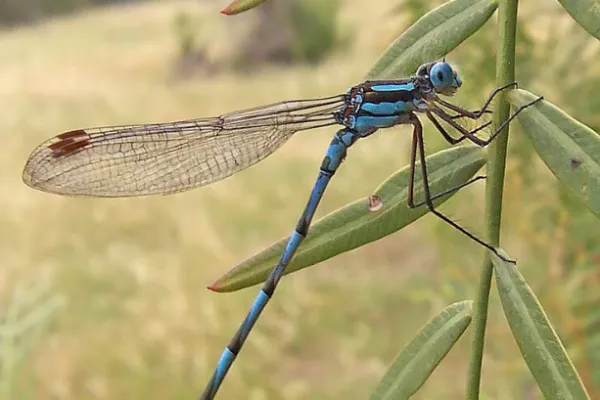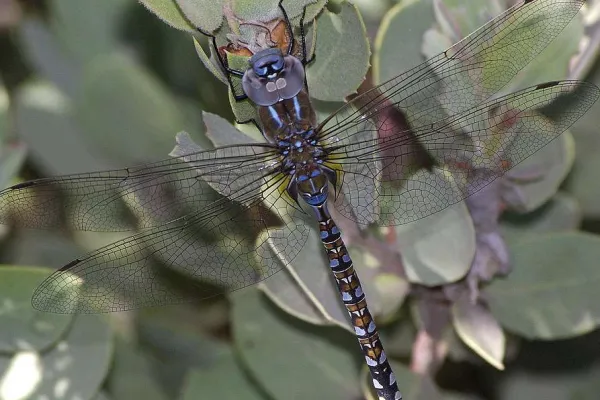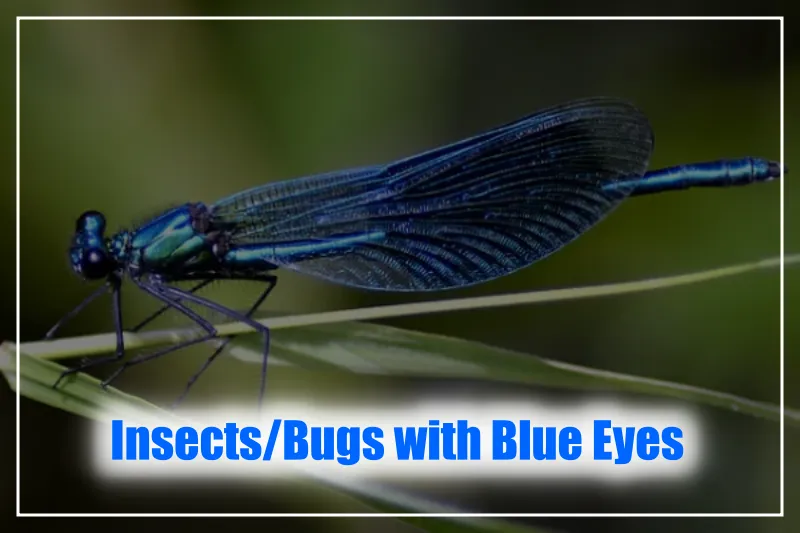Have you ever noticed insects with blue eyes? No, because I also never imagined that some insects could actually have blue eyes until I met the blue-eyed ensign wasp. The eyes of this wasp are so enchanting that they caught my attention immediately.
These creatures might look simple and ordinary, but their incredible blue eyes hide a secret world of wonder. So let’s explore the little world of these insects and admire them. Here is a list of 10 breathtaking insects with blue eyes.
10 Insects with Blue eyes
1) Blue-eyed ensign wasp
- Scientific Name: Evania appendigaster
- Size: up to 7 mm long
- Identification: Have black body with brilliant blue eyes
The first insect we have on our list of insects with blue eyes is the blue-eyed ensign wasp. These wasps are known for their incredible, brilliant blue eye color.
This Asian-origin species acts as a parasite, especially on cockroach eggs. Females of these species used to penetrate tough cockroach egg cases with their ovipositor and lay eggs in them.
Their size of 7 mm and black body with blue eyes make them stand out in the crowd.
2) Blue ringtail

- Scientific name: Austrolestes annulosus
- Size: up to 3 cm
- Identification: Have blue body with minimal black markings
Blue ringtail, as their name indicates, their body is striking blue with minimal black markings. Both sexes show a striking difference in their appearance.
Females of this species have black and pale coloration. People often mistake them for Coenagrion lyelli or Caliagrion billinghursti.
One can easily find them in Australia near still water sources like ponds, pools, lakes, etc.
3) Common blue damselfly

- Scientific name: Enallagma cyathigerum
- Size: 32 to 35 mm
- Identification: Have mushroom-shaped mark on segment 2
Common blue damselfly, common bluet, or northern bluet are some of the common names of Enallagma cyathigerum.
They are commonly found in Russia, Sweden, Norway, Finland, the United States of America, and South Korea, inhabiting freshwater.
Males are typically brighter than females. Univoltine and semivoltine are the two different life cycles they exhibit depending upon their latitudes.
4) Blue-eyed Darner

- Scientific name: Aeshna multicolor
- Size: 65 to 70 mm
- Identification: Their abdomen has a repetitive pattern of small white triangles, red-brown circles, and blue triangles on each segment
The blue-eyed darners are turquoise blue in color with large, vivid blue eyes. Their abdomen has a repetitive pattern of small white triangles, red-brown circles, and blue triangles on each segment.
They are found in North and South America, inhabiting freshwater resources including ponds, lakes, slow-moving streams, and marshes.
Couples spend a lot of time finding locations to perch and lay eggs.
5) Blue-eyed Cicada
- Scientific name: Magicicada cassinii
- Size: 24 to 27 mm
- Identification: This variant has remarkable blue eyes
Have you ever heard the voices of cicadas? Cicadas are famous for their loud calls during mating season. Let me introduce you to the fascinating blue-eyed cicada.
This blue-eyed variety of Magicicada cassinii is distinguished by its striking blue eyes. These 24 to 27-mm cicadas are endemic to North America.
There was a myth about these blue-eyed cicadas that various biological laboratories, including Vanderbilt University, were offering up to a million dollars as a prize to anyone who delivered them the cicadas, which they cleaned out.
6) Blue Eyes Lacewing
- Scientific name: Nymphes myrmeleonides
- Size: up to 4 cm
- Identification: Have orange body with large blue eyes
You can spot these blue-eyed lacewings in Australia, from New South Wales to Queensland.
These blue-eyed lacewings are called so because of their striking blue eyes.
Their body is slender and can easily attain a length of up to 4 cm. Their wings are longer than their bodies and have a white tip on their wings.
These insects are frequently found in sandy or loose soil conditions, where they may build their distinctive holes for catching prey.
7) Blue ant
- Scientific name: Diamma bicolor
- Size: up to 25 mm
- Identification: Have metallic blue-green body with red legs
You should be familiar with these blue ants since I discussed them in a previous article. These blue ants have a distinctive metallic blue color with red legs.
Apart from their coloration, their eye color is also distinct, which is blue. This South and Southeast Australian endemic species can grow to be up to 25 mm long.
These fast-moving ants usually burrow under the leaves to escape from predators.
8) Blue-eyed Horse Fly
- Scientific name: Tabanus americanus
- Size: 22 to 27 mm
- Identification: Have large blue compound eyes
The blue-eyed horsefly is a species of horsefly that belongs to the family Tabanidae.
This blue eye morph, Tabanus americanus, is known for its striking eye color and is found in North America, from the United States to Canada.
They are brown in color and have segmentation on their abdomen, which is very prominent from the outside as well.
Stay in open areas where cattle or livestock live, near water sources.
9) Blue Dasher dragonfly
- Scientific name: Pachydiplax longipennis
- Size: 25 to 43 mm
- Identification: Have yellow-striped thorax
Pachydiplax longipennis, sometimes known as the blue dasher dragonfly, is a tiny dragonfly found across North America and the Bahamas.
These species have wings that are longer than their bodies and are distinguished by their vivid blue colors, blue eyes, and agile flying patterns.
They have a noticeable sexual dimorphism. Males have more vibrant colors than females.
Their wing color changes with temperature, which aids in thermoregulation, flying performance, and territorial security.
10) Blue leafhopper
- Scientific name: Poochara cumatilis
- Size: less than 1 cm
- Identification: bright blue in color with dark blue eyes
This blue leafhopper, Poochara cumatilis, is widely distributed in Southeast Asia.
They have bright blue coloration on their whole body with dark blue eyes.
These blue leafhoppers, which are very rare and inhabit forested areas, can be seen easily in the rainy season.
These suction feeders sometimes become a problem for farmers when they are present in large numbers.
Conclusion
In conclusion, these blue-eyed insects are an uncommon sight for humans. They are well-known for their vibrant colors and amazing blue eyes.
Their eye color not only makes them attractive but also serves as a warning to their predators. I hope you liked learning about these animals.
Also Read:

Being a zoology student I’m always been fascinated toward animals especially insects. I love to do research and learn about different animals. As a writer I want to share my thoughts about nature through my articles. Apart from this you can find me exploring the new places and voice notes.
